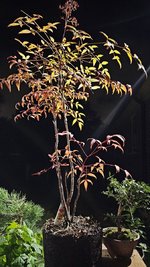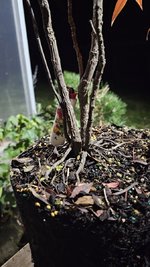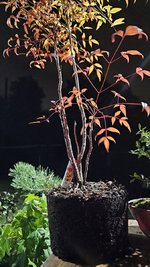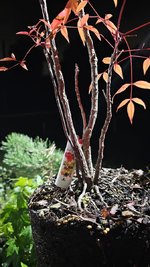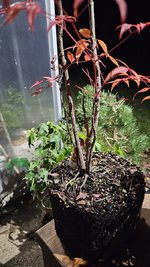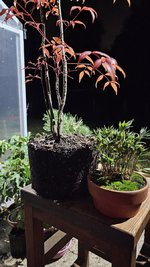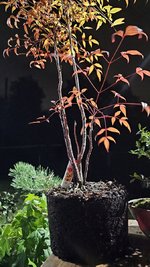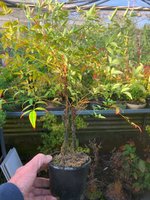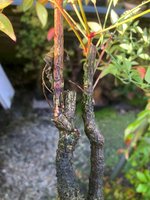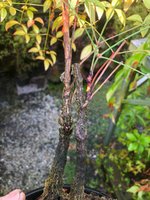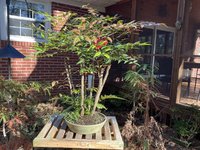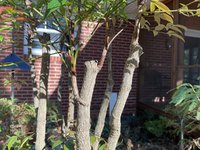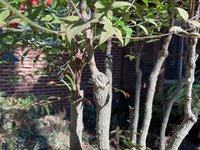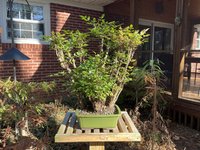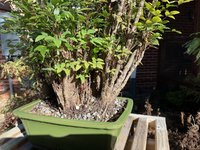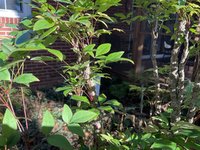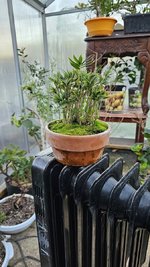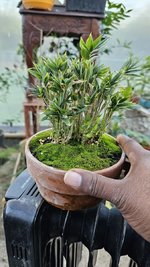I don't grow Nandina because it is not quite winter hardy at my location. Although., I have not tried again since my climate has warmed a bit. I used to be in zone 4b or 5a, now I'm in 5b, and I am finding zone 6a plants are doing pretty good lately. Have been living in the same house for 40 years.
When I first moved in I planted one of the most cold hardy bamboos I could locate, Phyllostachys aureosulcata, 'yellow groove bamboo'. It proved to be rhizome hardy, but tended to kill to the ground most winters. These days it remains evergreen 3 out of 5 winters. I routinely get 12 foot tall canes if I water and fertilize in spring. 6 to 8 foot tall canes if I leave it alone. Its very pretty if one spends a few hours twice a year "grooming" the grove, cleaning up and removing dead canes, weeds and out of bounds canes. If neglected it can become a extremely unkempt, and overgrow an area if neglected several years in in row.
My favorite source for bamboo is Bamboo Garden Center. They have good quality, healthy divisions available, at reasonable prices. Though for winter hardiness reasons, I suggest ordering in spring. If you are in Michigan, autumn orders should probably be kept in a cool greenhouse for spring planting.
Bamboo Plantation Garden Center! - The best prices on Bamboo plants, bamboo control products and specialty nursery plants.

www.bamboogardencenter.com
There are at least a dozen species of true bamboo that will be reliably rhizome hardy in zone 5, and occasionally evergreen. Phyllostachys nuda is the most cold hardy known of the taller bamboos, but 8 to 12 feet is probably maximum no matter what you do in zone 5, regardless the species. Phyllostachys aureosulcata has some great color forms, look for 'Spectabilis' and 'Aureocaulis' also known as 'Golden Temple'. Avoid black bamboo, Phyllostachys nigra, black bamboo, as it is flowering world wide and the new seedlings have not been grown long enough yet to see if they will have black canes. Size of canes is climate dependent. P. auerosulcata will be 8 feet tall in zone 5, 10 to 15 feet tall in in zone 6 and 25 to 30 feet tall in zone 7. It is fairly "tame" in zone 5, it is wildly invasive in zone 7 and 8.
Bamboo is truly beautiful, very lovely landscape plant. But if you plant bamboo, you need to know how to remove bamboo. Just a fact of life.
A root barrier to confine a planting is absolutely necessary, no matter where you plant bamboo. Do yourself a favor, plan ahead, and then you won't have problems later. Barrier should be at least 24 inches in depth, or deep enough to hit hardpan clay. Barrier should also be thick enough, 3/8 in cross link polyethylene will work, anything thinner will be pierced by the sharp tip of the rhizome. Sidewalks, compacted gravel driveways work well as barriers. In the event of escapes, cut off out of bound canes at ground level and dab on a little herbicide intended to kill grass. Roundup works. Digging rhizomes without using herbicide is back breaking and requires persistence. It can take a could years to eliminate an established planting of bamboo. So only plant it where you are pretty sure you want to leave it long term.



 pun.. heheheh to enjoy and put into a pot. And for your viewing pleasure here it is.
pun.. heheheh to enjoy and put into a pot. And for your viewing pleasure here it is.